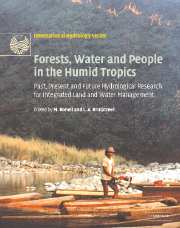 Forests, Water and People in the Humid Tropics
Forests, Water and People in the Humid Tropics from Part V - Critical appraisals of best management practices
Published online by Cambridge University Press: 12 January 2010
INTRODUCTION
Malaysia has a long experience of forestry management, with the Forestry Department of Peninsular Malaysia being established in 1901. Measures to improve the prospects of natural forest regeneration after the first cut were first applied in 1910, improved in 1927, and again in 1950 with the introduction of the Malayan Uniform System (MUS) and latterly with the application of the Selective Management System (SMS) since the late 1970s (Thang, 1987; Jusoff and Mustafa, 1996; Dawkins and Philip, 1998, p. 154). The guidelines associated with these management systems aim to enhance regeneration in part by limiting collateral damage to trees remaining after the cut. This has the indirect effect of: (a) restricting damage to natural canopies and hence reducing changes to transpiration and wet-canopy evaporation (Asdak, et al., 1998, Chappell, et al., 2001, van Dam, 2001), and (b) requiring more careful skidding or yarding systems, thereby reducing ground damage (Pinard et al., 2000) and hence soil erosion (Douglas et al., 1993; Chappell et al., 1999).
Methods of commercial forestry in Malaysia developed greatly from the mid-1950s onwards, with Malaysian companies now expanding their operations to other tropical countries. Inevitably, with the advancement of forestry technology has come a greater degree of mechanisation, and the potential for greater impact on the physical and biological environment (Wyatt-Smith et al., 1964).
To save this book to your Kindle, first ensure no-reply@cambridge.org is added to your Approved Personal Document E-mail List under your Personal Document Settings on the Manage Your Content and Devices page of your Amazon account. Then enter the ‘name’ part of your Kindle email address below. Find out more about saving to your Kindle.
Note you can select to save to either the @free.kindle.com or @kindle.com variations. ‘@free.kindle.com’ emails are free but can only be saved to your device when it is connected to wi-fi. ‘@kindle.com’ emails can be delivered even when you are not connected to wi-fi, but note that service fees apply.
Find out more about the Kindle Personal Document Service.
To save content items to your account, please confirm that you agree to abide by our usage policies. If this is the first time you use this feature, you will be asked to authorise Cambridge Core to connect with your account. Find out more about saving content to Dropbox.
To save content items to your account, please confirm that you agree to abide by our usage policies. If this is the first time you use this feature, you will be asked to authorise Cambridge Core to connect with your account. Find out more about saving content to Google Drive.